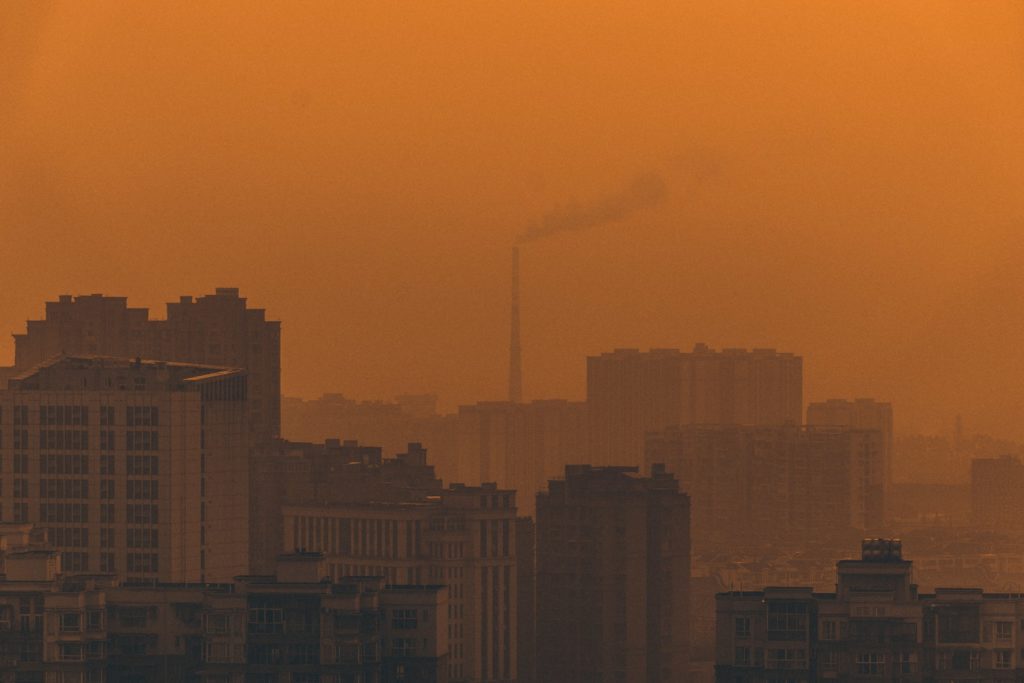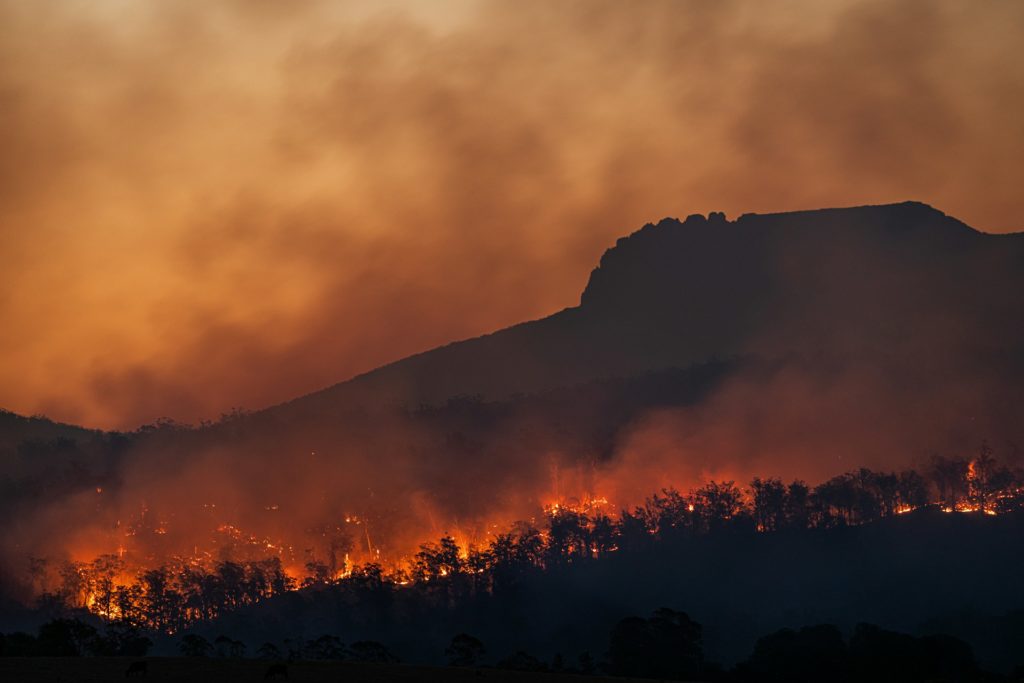Clearing the Air: The Silent Perils of Air Pollution
By Dr Catriona Nguyen-Robertson MRSV
Senior Editor, Science Victoria

As I cycle around Melbourne, I sometimes wonder whether the health benefits of my exercise are negated by the polluted air that I breathe in on roads with high traffic volume.
I have travelled to cities where the smog is so thick that it lingers visibly in the air, and triggers asthma that I never knew I had. Smoke from the devastating 2019-2020 Black Summer bushfires exposed millions of people to air pollution across eastern Australia – I was among many who sought a suitable mask to wear outdoors.
From the smog looming over cities to smoke inside our homes, air pollution poses a major threat to our health and our climate. The combined health impacts of ambient air pollution and household air pollution contribute to an estimated 7 million premature deaths annually.1
This makes it the world’s greatest environmental cause of preventable disease and premature death.2
In this edition of Science Victoria, we discuss the four planetary crises. Climate change and air pollution go hand-in-hand: they make each other worse. Climate change leads to more frequent and severe bushfires, which contribute to air pollution. But similarly, policies that reduce air pollution are also vital for mitigating climate change as they share common drivers, such as fuel combustion.
What is air pollution?
Air pollution refers to the presence of harmful or excessive quantities of pollutants in the air that endanger human health, the environment, and the planet. Pollutants can come from naturally occurring events like bushfires and volcanic eruptions, but they are primarily generated by human activities such as industrial processes, vehicle emissions, and the burning of fossil fuels.
Air pollutants consist of both airborne particles, called particulate matter (PM), and gases.
Inhalable particles vary in size and are a common measure of air pollution. Sources of larger, coarse particles are mainly pollen and wind-blown dust from erosion, agricultural spaces, roadways, and mining operations. The finer particles can be derived from combustion of fuels and chemical reactions between gases already in the atmosphere.
Gases that contribute to air pollution can sometimes be imperceivable – colourless, odourless, and/or tasteless – yet toxic. Carbon monoxide (CO) is produced by the incomplete combustion of fuels such as wood, petrol, charcoal, and natural gas, with the predominant source of CO in the air coming from motor vehicles. Other common polluting gases include nitrogen dioxide (NO2) and sulphur dioxide (NO2), both of which are released from fuel combustion. Lastly, ground level ozone (O3), not to be confused with the ozone layer in the atmosphere, contributes to smog and is produced when other gas pollutants react in the presence of sunlight.3
This is not an exhaustive list of pollutants. Formaldehyde, lead, mould, black carbon, and other pollutants are also listed by the World Health Organisation as air pollutants.3 And they all have an impact on our health.

How does air pollution impact us?
PM is capable of penetrating deep into the lungs and entering the bloodstream, before spreading to other parts of the body.4 Pollutant gases also directly damage the respiratory tract – and CO can cross into the bloodstream, where it makes it difficult for our blood cells to bind to oxygen, essentially depriving tissues of oxygen. In addition, these pollutants can work in tandem to damage lung cells, as seen by a recreation of lungs in a lab that were impacted by NO2 and PM.5
In the short-term, exposure to air pollution irritates the respiratory tract. As I discovered in Beijing (which, at the time, had a “red alert” air quality warning)6 it can exacerbate allergies, allergic rhinitis (runny nose), eczema and asthma, and long-term exposure is increases the risk of developing these in the first place.7
Air quality affects our health throughout our lives. Even before birth, the growth, development, and overall health of unborn babies is impacted by ambient air pollution.7 Young children who are exposed to particulate matter, carbon monoxide, or ozone for as little as one day can also incur a higher risk of disease in adulthood.7,8 Air pollution can alter the regulation of their immune systems, stunt lung development, and increase blood pressure, suggesting that even at a young age, the immune, respiratory, and cardiovascular systems are negatively impacted by exposure.8,9
Later in life, air pollution increases the risk of non-communicable diseases. Heart disease, stroke, type 2 diabetes, lung disease, and cancer are all leading causes of illness and death for Australians – and exposure to air pollution increases our risk for all of these.9 Air pollution also increases the risk and severity of respiratory infections such as pneumonia, influenza, and COVID-19.10
At a population health level, air pollution exacerbates health inequities. Some of the most vulnerable people in Australia are at higher risk of worse health outcomes from air pollution exposure, including socially disadvantaged populations and First Nations Australians.11 Around the world, people living in low- and middle-income countries disproportionately bear the burden of air pollution with as much as 89% of air pollution-related premature deaths occurring there.12
What can we do about it?
There is extensive evidence on the short-term and long-term health impacts of air pollution – now we need to decide what we will do with this evidence. Energy generation, transport systems, climate change – many factors feed into the quality of the air that we breathe.
No single policy will adequately tackle the problem, and we therefore need coordinated approaches to make our air safer.
Air is shared – most sources of outdoor air pollution are well beyond the control of individuals. We need policymakers in sectors like energy, transport, waste management, urban planning, and agriculture to implement policies to reduce air pollution. The use of clean technologies that reduce industrial smokestack emissions, shifting to clean modes of power generation, supporting scientifically-informed policies to reduce the frequency and severity of bushfires – there are many actions we can collectively take.
Something to consider is that children are particularly vulnerable to air pollution and will suffer the health consequences of today’s air quality in the future. Yet environmental policies have traditionally not taken them into account, as the data that informs policy have been derived from studies on adult humans (or adult animals), without considering children’s distinct physiology.
Additionally, air pollution decisions should ideally be informed by specific risk assessments to children’s health and set out a framework to protect children and adolescents – especially in child-centric settings like schools. We need to be constantly assessing the data. A review in 2022 revealed that inhalation of PM increases rates of diseases and death even when inhaled at levels below existing standards,13 and the US Environmental Protection Agency has tightened its guidelines in January this year as a result.14
We inhale six litres of air every minute on average.15 Even small amounts of pollution in air can have a major impact on our health over time. The air that we breathe is communal, and air pollution affects everyone. The Centre for Safe Air, funded by the National Health and Medical Research Council, has recently been established to support the translation of scientific evidence into policy and practice.16 We need coordinated leadership across sectors and evidence-based action to ensure that we all can enjoy the benefits of safer air.
References:
- World Health Organization. (2019, July 30). Air pollution. who.int/health-topics/air-pollution
- Fuller, R. (2022). Pollution and health: a Progress Update. The Lancet Planetary Health, 6(6). doi.org/10.1016/S2542-5196(22)00090-0
- World Health Organization. (2021). Types of pollutants. Air quality, energy and health. who.int/teams/environment-climate-change-and-health/air-quality-and-health/health-impacts/types-of-pollutants
- Schraufnagel, D. E. (2020). The health effects of ultrafine particles. Experimental & Molecular Medicine, 52(3), 311–317. doi.org/10.1038/s12276-020-0403-3
- Bateman, J., et al. (2023). 25 Using Advanced in Vitro Approaches to Elucidate the Differential Toxicity of Nitrogen Dioxide and Particulate Matter in Ambient Air Pollution. Annals of Work Exposures and Health, 67(Supplement_1), i46. doi.org/10.1093/annweh/wxac087.112
- Reuters. (2016, February 22). Beijing raises “red alert” threshold for air pollution warning. The Guardian. theguardian.com/world/2016/feb/22/beijing-raises-red-alert-threshold-for-air-pollution-warning
- European Environment Agency. (2023, April 24). Air pollution and children’s health. eea.europa.eu/publications/air-pollution-and-childrens-health
- Prunicki, M., et al. (2021) Air pollution exposure is linked with methylation of immunoregulatory genes, altered immune cell profiles, and increased blood pressure in children. Nature Scientific Reports, 11. doi.org/10.1038/s41598-021-83577-3
- Schraufnagel, D. E., et al.(2019). Air Pollution and Noncommunicable Diseases: A Review by the Forum of International Respiratory Societies’ Environmental Committee, Part 2: Air Pollution and Organ Systems. CHEST, 155(2), 417–426. doi.org/10.1016/j.chest.2018.10.041
- Ko, U., & Kyung, S. Y. (2022). Adverse Effects of Air Pollution on Pulmonary Diseases. Tuberculosis and Respiratory Diseases, 85(4) 313-319. doi.org/10.4046/trd.2022.0116
- Pillay, D.G., et al. (2023). Safer Air, Healthier Communities: Ten reasons for investment in Australia. Centre for Safe Air. safeair.org.au/safer_air_healthier_communities
- World Health Organization. (2022). Ambient (outdoor) air quality and health. who.int/news-room/fact-sheets/detail/ambient-(outdoor)-air-quality-and-health
- US Environmental Protection Agency. (2022). Supplement to the 2019 Integrated Science Assessment for Particulate Matter (Final Report, 2022). cfpub.epa.gov/ncea/isa/recordisplay.cfm?deid=354490
- US Environmental Protection Agency. (2024, January 24). Final Reconsideration of the National Ambient Air Quality Standards for Particulate Matter (PM). epa.gov/pm-pollution/final-reconsideration-national-ambient-air-quality-standards-particulate-matter-pm
- Pleil, J. D., et al. (2021). The physics of human breathing: flow, timing, volume, and pressure parameters for normal, on-demand, and ventilator respiration. Journal of Breath Research, 15(4), 042002. doi.org/10.1088/1752-7163/ac2589
- Centre for Safe Air. safeair.org.au






